Summary
The program is a story along with some videos explaining grammar, pronunciation, and culture. There are also quizlet quizzes for the words.
- Price: $397
- Conclusion: Misleading and not worth the price.
Take a look at the next sentence below.
“This is a brand new way to learn Japanese.”
Sounds nice, right? New. Never done before. No-one else has it in the hundreds of years people have been learning languages.
So, surely you’re at least tempted to give it a try.
And just like that, any random passerby is fooled by marketing… because they don’t know how “NEW” it really is. That’s exactly how Storylearning Japanese Uncovered starts out.

In this StoryLearning Japanese Review, I’ll point out a few marketing trickery used in overhyping something that’s actually… not exactly new.
Because it seems like every other review is 5-star positive… (for reasons why you’ll learn below.)
What StoryLearning really is… is a story and with some videos explaining grammar, pronunciation, and culture. You read a story. Then you watch some videos with explanations. Then you do some quizzes that are publicly available for free on quizlet.
But it also comes with a lot of misleading claims to make you think you’re getting something revolutionary here.
The next sentence says that there’s even a trademark for “Storylearning,” which to the unaware means “oh, it’s backed by law or something so it must work.” Except just the word “Storylearning” is trademarked. Nothing to do with it actually being new or working.

Why, you could trademark the phrase “fluent in 10 seconds” and all it means is… others can’t use it… but you and I know no-one’s going to be fluent in 10 seconds.
The page goes on to say…

Again, “Brand new.” “Invented.”
Except, learning through stories is not new and it certainly hasn’t been invented any time recently.
StoryLearning goes on to claim that…wait… what makes it unique is a “double activation trick.” Made-up marketing words to make you think this is a new method.
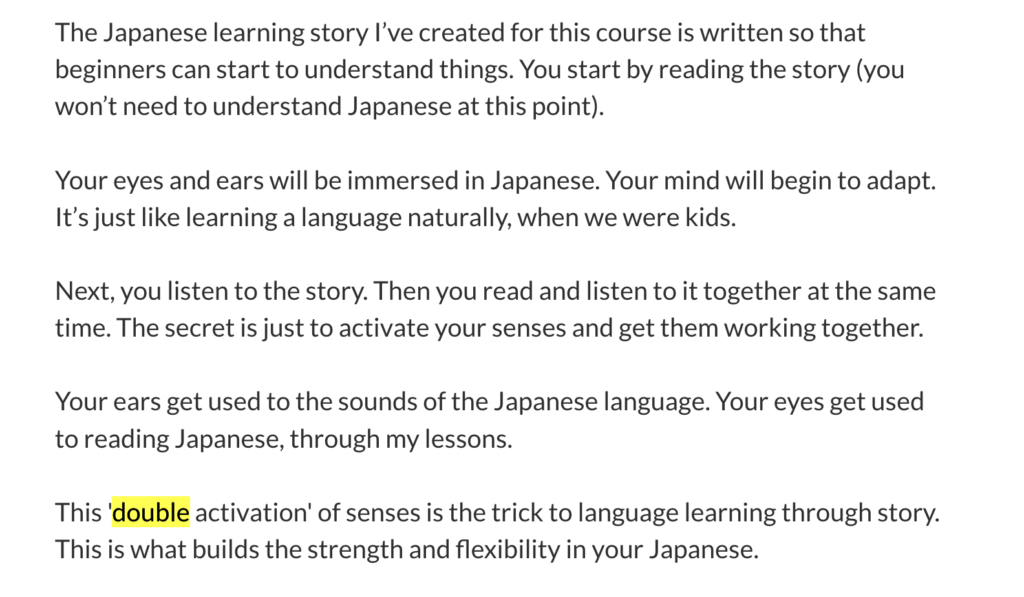
So, you start by reading. Then you listen. And that’s double activation?
You mean “input”… which practically every program and resource on earth offers. First you do input (take in the language). Then you get it explained so you understand the input.
Page goes on to say you learn in reverse, again making you think it’s different.
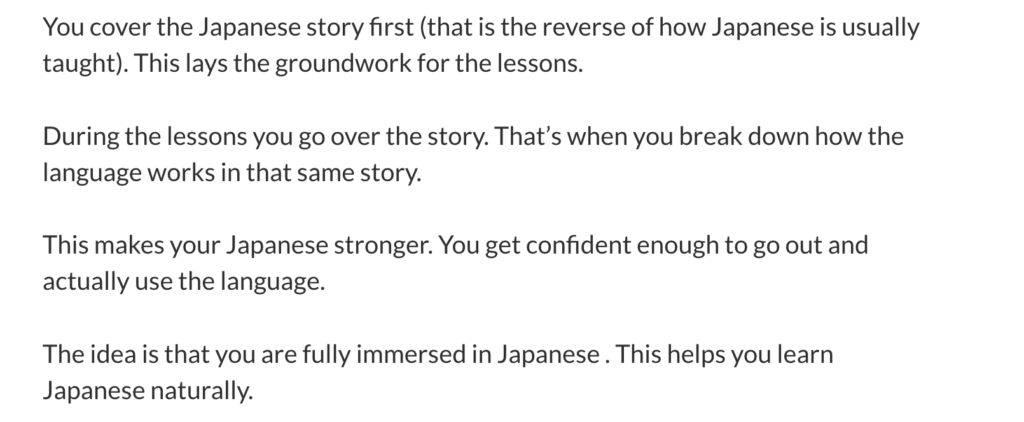
Again, every program does that. First you get the language (input). Then you get it explained. Even with a textbook like Genki, which also starts off with stories. And without a $300 price tag.
The mention of “full immersion” is also very odd considering there is a LOT of English in the course… and that things still need to be explained, which is exactly what happens in schools, textbooks, and other resources that Storylearning bashes for “teaching.”
It’s the same stuff just repackaged.
We could go on and on but you may be wondering…
But, Aren’t Stories a Good Way to Learn Language?
We all enjoy stories, right? So, surely we can learn language through it, right?
And if you get a story that starts with something juicy like…
“She shrieked when he kicked the door open…”
You’ll be hooked and want to continue, right?
Well… let’s agree on one thing. You did not read that in Japanese. And as a beginner, if you read that line… well, you wouldn’t be able to read it. Nor would you be able to understand it.
You see, we enjoy stories that we understand.
If you’re listening to something you can’t understand… guess what… you’re not hooked. Because you need it explained. And if you need it explained, you’re not “immersed” in the story and are listening to an explanation. You may as well be reading a textbook or be sitting in class.
Learning a language through stories is a lot like…
- Learning through Netflix…
- Learning through TV shows…
- Learning through music…
All sound great on paper… except… they’re 100% useless if you don’t understand anything. Terrible for beginners. You don’t know enough of the language. It’s like listening to Spanish soccer commentators and all you understand is “gooooooaaal.” Good luck learning anything else.
And if you first hear gibberish and then you get the gibberish explained…
…how hooked are you really?
StoryLearning relies on the idea that we all like stories. If we like stories, you will likely believe that you can use to learn Japanese fast. Except if you don’t understand anything and need it explained — that’s clearly not true.
The page goes on to say that you’ll learn naturally, as a child.

The problem is…
Your parents didn’t read you stories in 100% Japanese and you not knowing anything went “oh, great Mom, I was hooked! I totally understood everything.”
Your parents read to you in your native language (say English). When you were a kid, you knew enough English to learn through context… or your parents explained it to you.
The whole claim of “kids learn naturally through stories” goes out the window because… 1) it applies to their native language and 2) well, is your Japanese at a toddler level? No? Then good luck.
You see, stories CAN work…
Which is why much cheaper graded-readers exist… BUT… the language has to be at YOUR level, again, which is why graded readers exist.
It can also work IF your Japanese is advanced for you to understand through context.
StoryLearning is a repackaged version of Stephen Krashen’s input method – where you do input with material that you like and that’s at your level.
So, nothing new at best, and misleading at worst.
And maybe you should get graded readers instead. The kind you buy for $10-$30 on Amazon, instead of dropping $300+.

Other Resources Don’t Do This.

Storylearning also makes sure to say that other resources don’t do this.
So, that’s a false setup written to make you believe that ONLY Storylearning has the solution. It doesn’t.
Again, If you pick up a textbook… say, the Genki textbook, the thing HAS a story with dialogues at the start of every chapter…. that goes on from beginning to end.
If you’re learning with a product like JapanesePod101 or Pimsleur, they too have built in “stories” that evolve from lesson 1 to 2 to 3 while teaching you a language,
But it’s the good old us vs. them tactic, designed to make you think that “all the rest can’t do it like we do.”
Why Are These So Many Positive Reviews?
“Gee, Linguajunkie, if it’s that bad, why are so many blogs promoting it and writing nice things? And all the big name polyglots?”
Oh, you sweet summer child. It’s simple.
Money.
All of these guys get paid 50% commission to push the a $397 product. They all know each other.
But, if you go to the most critical side of the internet — Reddit, you’ll see reviews that are a bit different.
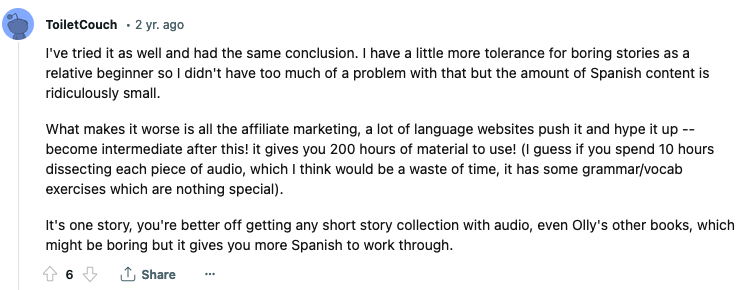

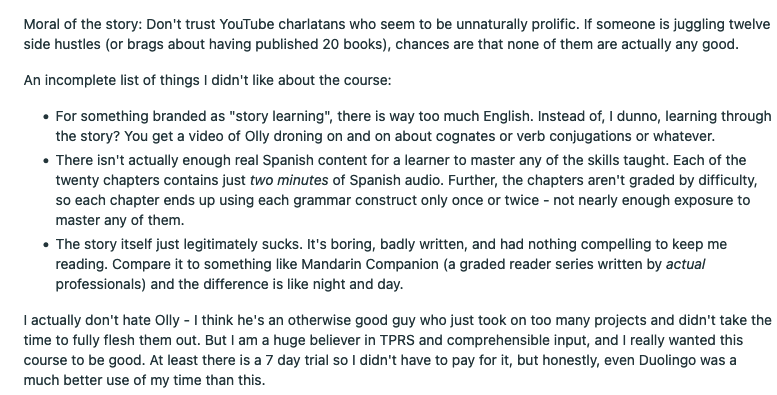
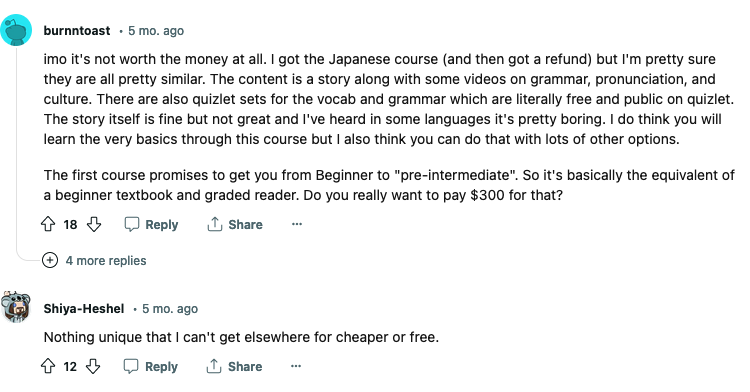
Alternatives to Storylearning’s Japanese?
Look, if you insist on learning with stories, you can do it for way less with…
Graded readers.
Parallel readers.
Audiobooks with read-along transcripts. They exist on Audible.
Any textbook. Almost every single textbook includes stories at the start of every chapter… and then teaches the grammar and vocabulary in that story. Almost every textbook in today’s day and age also includes audio.
– The Main LinguaJunkie